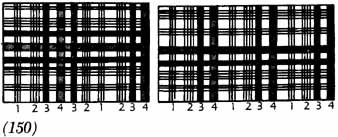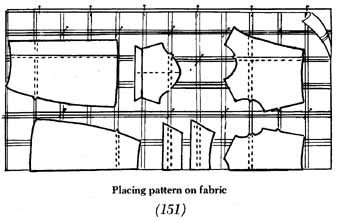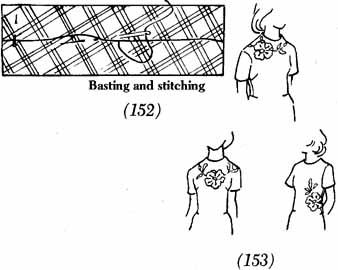Plaids and stripes. Choose a woven plaid or stripe (Section 5). The
fabric can have an even or an uneven arrangement of the design. Even plaid designs
have the same arrangement in both lengthwise and crosswise grains.
If folded
diagonally through the center of the design, colors and spaces match in both
directions. Even stripes will match in both directions and diagonally. In uneven
plaids the colors and spaces can't be matched in both directions. Uneven stripes can't be matched in both directions.
Uneven plaids and stripes must be cut “one way” and require greater yardage
as well as the allowance for matching.
They present many problems and are not
for beginners. (See diagram 150.)
Matching. See Section 5 for allowance for matching. Choose pattern carefully. If an illustration is shown in plaid or stripe you will know the style is suitable. Every dart and seam distorts the pattern of the plaid and is obvious.
PLACING PATTERN on FABRIC
1. Every plaid has a dominant stripe. It should run down the center back, center front of bodice and skirt; also center of sleeves and collars.
2. The crosswise dominant stripe should not fall on the largest part of the bust or the hip. Consider the placing of the stripes in regard to finished hem edge of sleeve and skirt. Will they form a pleasing border?
3. Consider the lengthwise stripes for the belt. Will there be a center? Fold fabric and observe before cutting.
4. Fold fabric on center of design. Pin fold line. Pin the layers together at regular intervals, matching designs perfectly. Match and pin selvages.
5. Place and pin pattern so side seams will match at notches, at upper and lower edges. Side seams on bodice will not match above the bust dart. Match shoulder seams.
6. The curve of most sleeve caps makes it impossible to match the entire seamline. Match the back armhole notches. The back is more noticeable when the garment is being worn. Front armhole tends to fold in to body.
7. Cut collars, yokes, pockets and other trimmings so design matches that of the garment at stitching lines. For a decorative effect these pieces may be cut on the bias.
8. If garment is collarless, a square neckline is attractive. Observe position of design in relation to finished neck edge. Remember: The design at bust level is more important because the neckline can be raised or lowered.
BASTING and STICHING
To match perfectly, slip baste seam stitching lines on right side of fabric. Turn and pin one seam allowance to wrong side. Place folded edge over corresponding piece, pin or use magic tape. Slip baste, using stitches small enough to prevent slippage when machine stitching. Magic tape will hold pockets in position for machine stitching. (See diagram 152.)
The Smooth Even Feed presser foot is ideal for stitching plaids and stripes.
Large, bold, isolated designs require thought and planning before cutting.
* Choose pattern carefully. Collars, cuffs, pocket flaps, etc., will not be attractive because of overlapping of designs.
* Avoid placing a large motif on bust or hip.
* Consider design in relation to neckline and hem edges.
* A belt will break up the design.
* Designs should match as evenly as possible on seam lines.


Placing pattern on fabric

Basting and stitching
